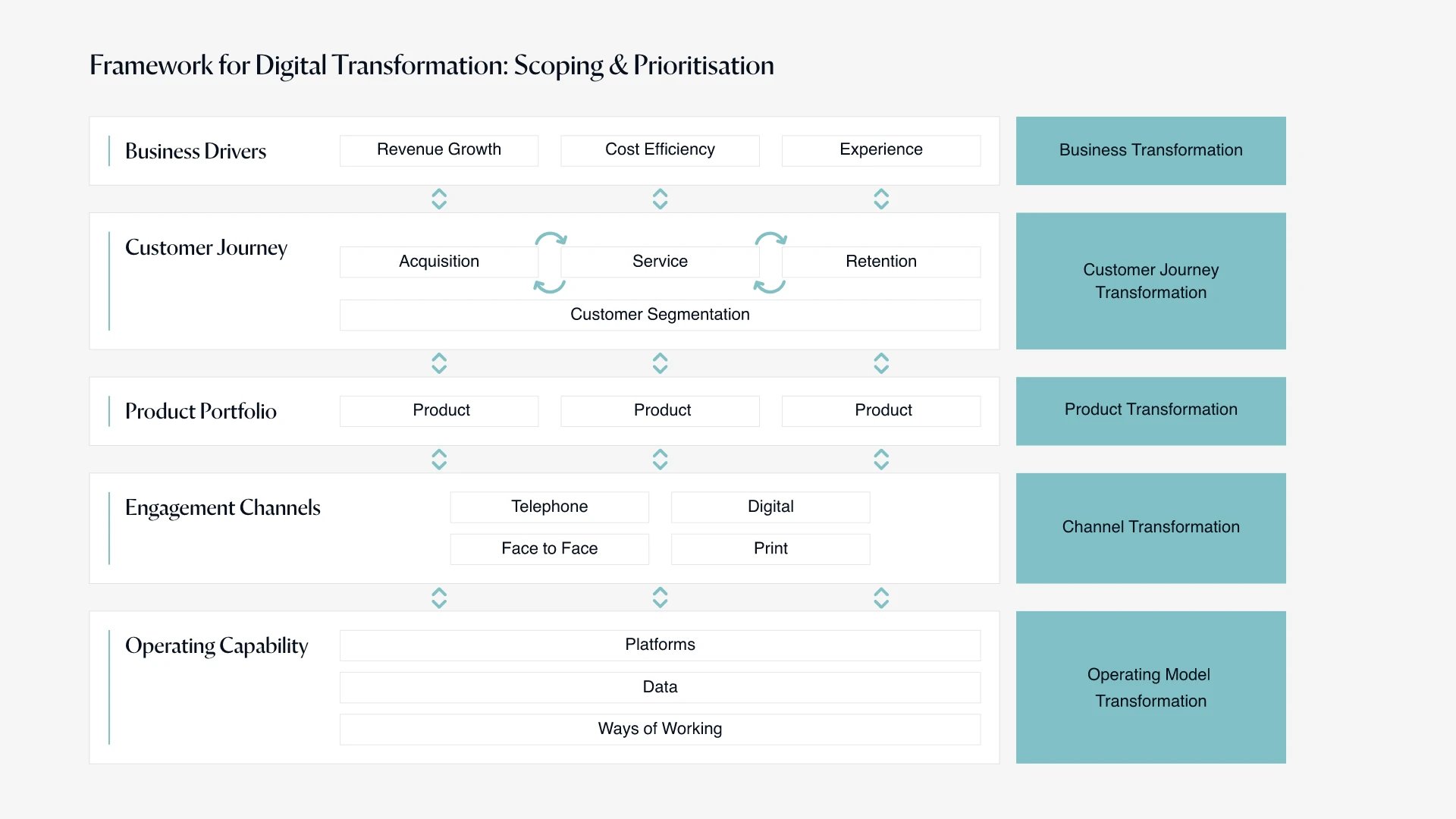
In recent years, the Covid-19 pandemic compounded the need for greater efficiency and flexibility for all organisations. This is being achieved, in part, through organisations quickly adapting their business model to the change of pace and accelerating their digital transformation journey.
In this guide, we’ll explain what digital transformation is, why it’s important for your business, showcase examples of digital transformation in action, and set out a roadmap for a successful digital transformation strategy.
What is digital transformation?
Digital transformation refers to the process of using digital technology to fundamentally change the way a business operates and delivers value to customers. It involves adopting new digital tools and processes to streamline operations, improve efficiency, and create new business models. Essentially, it means using technology to transform traditional business practices into more modern, innovative ones that can help businesses to become more flexible in order to stay competitive.
At the heart of any digital transformation is a cultural shift which openly embraces new technologies and processes, and places significant investment in new infrastructure, software, and talent.
Why digital transformation should be important to your business
Effective digital transformation is critical to the long-term success of organisations, regardless of industry or location. According to research, 35% of business executives believe that digital transformation has aided them in meeting customer expectations more effectively and enhancing operational efficiency (40%). Additionally, 38% of executives intend to increase their investments in technology to deliver a competitive edge.
However, our own research has discovered that less than half of UK businesses consider themselves to be a digital-first business and less than half (44%) do not have a culture and technology environment which enables them to respond quickly to market opportunities and threats. Download our report ‘Digital transformation is dead. Long live business agility.’ to find out more.Digital technology and new business processes that come from successful digital transformation positively impact most, if not all, areas of business in any industry by increasing agility, efficiency, and improving the overall customer experience.
Effective digital transformation is instrumental in delivering commercial long-term growth and is evident in DCX’s own client base too. Since 2013, DCX has partnered with leading transport company FirstGroup to provide a 3-5-year programme of digital transformation initiatives. By embracing technology across all the brands in the group, investing in a digital experience platform, and managing data to deliver core CRM campaigns, FirstGroup has increased their revenue significantly and made impressive cost-savings.
Creating a digital transformation strategy that considers both business and customer needs puts an organisation in a strong starting position to kick off digital innovation initiatives. It gives you a competitive advantage over similar businesses that are yet to create or undergo their digital transformation plan.
Using digital transformation to create new business models
Digital transformation can enable businesses to create new revenue streams and new business models. For example, using digital transformation to reveal new opportunities for growth and innovation using analysed customer data and behaviour, which allows you to identify new market segments or product/service offerings that can drive growth.
Likewise, digital transformation can aid in the creation of new distribution channels. You could launch an ecommerce platform to reach new customers or partner with digital platforms to expand your audience.
How digital transformation improves the customer journey
Customer expectations have never been higher. Customers today are used to efficient and streamlined digital experiences on demand, whether that’s across a mobile device, tablet, or desktop.
Increasing customer engagement is often one of the key triggers for digital transformation programmes, as organisations seek to identify and engage with new potential customers and gain a competitive edge.
Digital transformation can significantly improve the customer journey by means of using technology and data to personalise the customer experience and deliver multi-channel communications at the right time, to the right audience.
By using data analytics and digital tools, organisations can better understand their customers' needs and preferences, and tailor their offerings accordingly. This can lead to more effective marketing messages, personalised product recommendations, and a more seamless omnichannel experience across different platforms.
Digital transformation can also enable your business to offer faster service through digital channels like chatbots and self-service portals.
Barriers to digital transformation
Lack of buy-in from the top - Buy-in from key stakeholders and the Board is essential to digital transformation success.
Budget strangulation - Digital transformation can be an expensive undertaking, due to the complexities of initiating and maintaining change across an entire business. The benefits will far outweigh the cost in the long term, but budget restraints can quickly cause a digital transformation programme to fail or under-perform.
Insufficient data analysis - All decisions during your transformation process should be data-driven. Ensuring your data analysis is accurate, logical, and effective, needs to be a key part of your plan.
Lack of employee buy-in– It’s your employees who will be fundamental in achieving a successful digital transformation. Employee push-back may doom even the best digital transformation programme to failure.
Examples of digital transformation in action
Here we look at a range of the latest digital transformation success stories, and some older ones. These successful digital transformation examples include case studies of DCX clients, and other large-scale efforts.
Northern – transport industry

DCX developed an award-winning website for Northern as part of their digital transformation strategy. With a reputation for poor customer service, the key objectives for the new website were to – increase passenger journeys, provide an improved customer experience, and create a positive ROI.
The new website was designed with all functions of the business in mind. Key stakeholders from teams such as HR, Comms and Customer Experience could update information quickly, while improving the website architecture enabled visitors to find the information they were looking for quickly. A Conversational UI feature was implemented on the website which was key to improving the customer service. With the new website, Northern saw a dramatic improvement in results.
100K
new customers
25%+
in transactions
43%+
in revenue
Read the full Northern digital transformation case study.
Coventry Building Society (CBS) digital transformation - financial services sector

The Coventry Building Society (CBS) is the second largest building society in the UK. Working with CBS, DCX crafted a new customer experience that aimed to improve customer engagement and keep CBS members at the heart of everything they do.
The digital transformation of Netflix - entertainment industry

In 2014, Netflix was reportedly worth $5.5b. By 2022, its worth had increased to over $155b - a more than 2,700% increase in value. Once a small DVD rental company, posting out DVDs on a daily basis, it now boasts 300 million subscribers in over 190 countries worldwide.
Digital transformation has been a key factor in the success of Netflix, enabling them to stay ahead of the digital curve and disrupt the film rental industry.
A true digital innovation leader, their focus on mobile user experience and adoption of digital streaming has made them a global household name. You can read the complete history of the growth of Netflix here.
Pfizer digital transformation strategy - pharmaceutical sector

Rockwell Automation describe in detail the results of digital transformation in just one Pfizer manufacturing facility leading to an extra 3 million doses of a product being produced.
By creating an all-encompassing vision that enabled a new organisational structure and processes designed around the way Pfizer wanted the plant to run, they built and adopted a successful digital transformation strategy and continue to reap the rewards.
What is a digital transformation strategy?
A digital transformation strategy is a plan that outlines how a business will make use of technology and digital tools to completely transform its operations and radically improve its performance.
A digital transformation strategy typically includes the following components:
- Vision - A clear and compelling vision that outlines the desired future state of the business after the transformation.
- Goals and objectives - Specific and measurable goals and objectives that are aligned with the vision and designed to drive the transformation forward.
- Assessment - An assessment of the current state of the business, including an analysis of the strengths, weaknesses, opportunities, and threats.
- Prioritisation - A prioritisation of the digital initiatives that will be undertaken as part of the transformation, based on their potential impact and feasibility.
- Roadmap - A detailed roadmap that outlines the specific steps that will be taken to achieve the transformation goals, including timelines, milestones, and resource requirements.
- Governance - A governance structure that defines the roles and responsibilities of different stakeholders and ensures alignment with the overall strategy.
- Culture - A culture that supports the digital transformation and encourages innovation and collaboration.
- Implementation - A plan for implementing and executing the strategy, including change management, communication, and training.
A digital transformation roadmap
A roadmap for digital transformation is a great way to plan out the stages and create a timeline for implementation.
It is the visualisation of your strategy, broken down into identifiable and measurable steps. It will also help identify gaps in and issues with current business systems.
A successful digital transformation roadmap helps ensure everyone involved knows and understands what is expected of them, and the timeframe they need to work to.

Why the CEO is a fundamental player in digital transformation
The CEO of a business is essential to a successful digital transformation strategy. Because they need to provide leadership, direction, and support throughout the process.
The CEO plays a crucial role in setting the vision and direction for the transformation, aligning it with the overall business strategy and goals, and securing the necessary resources to support it. The CEO also provides guidance and direction to the team responsible for executing the strategy, including setting priorities, establishing timelines, and monitoring progress.
They can help foster a culture of innovation and collaboration, which is critical to the success of a digital transformation programme. They are responsible for communicating the benefits of the digital transformation to stakeholders and ensuring that the organisation as a whole is committed to the process.
Key points to consider with digital transformation
Buy-in from the Board is essential
Several companies have identified the failure risk of digital transformation projects to be between 70-95%, so ensuring the success of your programme can be an uphill battle.
A successful journey must begin with buy-in from your Board and key stakeholders. Their disengagement is one of the most common reasons digital transformation fails.
Ensure you tailor your proposal to key goals of your organisation and ensure your Board truly understands the benefits of digital transformation for your whole organisation.
Watch our video to find out how to get your Board on-board with digital transformation.
People and culture
A successful digital transformation requires not only technological change, but also organisational and cultural change A digital transformation initiative can be challenging to implement without the support and buy-in of employees and without it being designed to make lives easier for customers.
An organisational culture that values innovation, collaboration, and continuous learning is more likely to support digital transformation than one that is resistant to change. Businesses should therefore identify areas where culture change may be needed and develop strategies to address any barriers.
Senior leaders should recognise the capabilities of their employees and assess whether they have the necessary skills and knowledge to support digital transformation. Upskilling or re-skilling employees, hiring new talent, or outsourcing certain tasks to third-party providers may be required to ensure success.
Data and analytics
Ensure your digital transformation strategy has a plan to capture and analyse all relevant data to make data-driven decisions.
Capturing and analysing relevant data is critical to the success of digital transformation. By collecting and analysing data from various sources, your organisation can gain insights into customer behaviour, market trends, and operational performance, and identify opportunities for improvement and optimisation.
Digital transformation technologies
Digital transformation involves a number or new and emerging technologies, including:
- Artificial intelligence - AI can be used to automate systems and responses, improve data and efficiency, while freeing up time for staff to better utilise their time with other, human-based tasks.
- Customer Data Platform - A customer data platform (CDP) is a software platform that collects, integrates, and manages customer data from various sources, such as websites, social media, mobile apps, and offline channels. CDPs are designed to provide a unified view of customer data, which can be used to gain insights into customer behaviour, preferences, and needs. They typically include features such as data ingestion, data cleansing, data enrichment, and segmentation, which enable businesses to create targeted marketing campaigns and personalised customer experiences. By providing a single source of truth for customer data, CDPs can help businesses improve customer engagement, increase sales, and drive business growth. CDPs are particularly useful for businesses that have complex customer journeys and need to manage large volumes of customer data across multiple touchpoints.
- Digital Asset Management System - Digital asset management (DAM) systems are software platforms designed to help businesses manage, organise, store, and distribute their digital assets. Digital assets may include images, videos, audio files, documents, and other types of media that are essential to an organisation’s operation. By centralising digital assets in one location, DAM systems help organisations avoid redundancies, reduce errors, and improve collaboration across departments and teams. Overall, DAM systems play a critical role in improving the management and distribution of digital assets, which can lead to greater efficiency and productivity for businesses of all sizes.
- Digital Experience Platform - A digital experience platform (DXP) is a software platform that helps businesses manage their digital interactions with customers, employees, partners, and other stakeholders. DXPs are designed to provide a seamless and integrated experience across multiple channels, including websites, mobile apps, social media, and other digital touchpoints. They typically include a range of tools and features, such as content management, personalisation opportunities, analytics, and marketing automation. DXPs enable organisations to deliver a consistent and engaging digital experience to their audience, while also providing valuable insights into customer behaviour and preferences. By providing a comprehensive suite of digital transformation tools, DXPs can help businesses of all sizes to improve customer engagement, increase brand loyalty, and drive business growth.
- Marketing automation - Marketing automation can be used to streamline all marketing campaigns, from social media and email to live chat and beyond.
- Cloud computing - Cloud computing will play a major role in your digital transformation programme. Offering cost-effective access with the flexibility to grow with your business, cloud computing is fundamental to any CIO looking to future-proof their business.
- Advanced analytics – One of the primary advantages of advanced analytics is the ability to uncover hidden patterns and relationships in data, which can be used to make better decisions and identify new opportunities. It also enables your business to make accurate predictions about future outcomes, which can inform strategic planning and resource allocation.
Discover how to implement a successful digital transformation strategy with DCX
Looking to digitally transform your business? Then it’s time to get in touch with our expert team at DCX. With our extensive range of services, including strategy and consultancy, digital product and platforms, creative concepts and content, data and AI, and marketing activation, we have everything you need to ensure a successful digital transformation.
Our bespoke offering of both digital and marketing expertise means that we can tailor our services to meet your specific needs, helping you to drive commercial growth and achieve your business objectives. Whether you are looking to streamline your processes, enhance customer experience, or increase your online visibility, our team has the skills and experience to help you stay ahead of the curve in today's fast-paced digital landscape.
So, why wait? Get in touch with us today and take the first step towards transforming your business for success.


